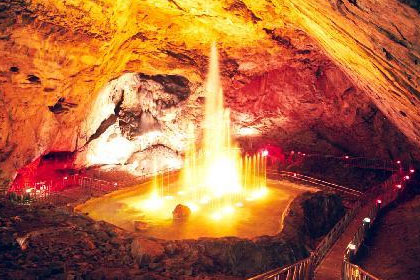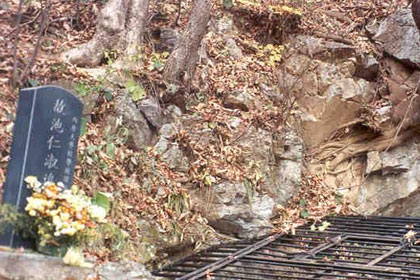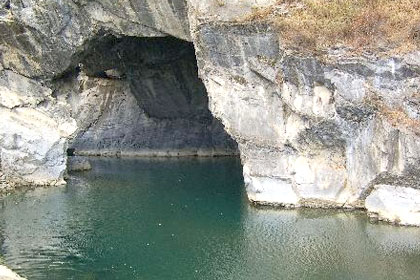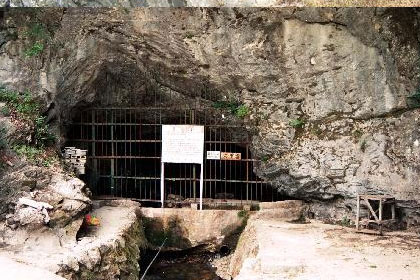Cave
Yongyeon Cave

Inquiry
Yongyeon Cave Management Office 033)550-2727
Location
283-29, Taebaek-ro, Taebaek-si (Hwajeon-dong)
Introduction
Yongyeon Cave, the Gangwon-do Local Monument 39 (designated in February 1980), is known to be the highest cave in the country as it is located at the lower ridge of Geumdaebong Peak at the elevation of 920m. It is a natural limestone cave with a variety of products including stalagmite, stalactite, stone pillars, cave pearls, cave coral, petrifaction, and curtain. Furthermore, a large plaza of 50m in width and 130m in length and a rhythm fountain located at the center of the cave are creating a mysterious atmosphere in harmony with natural products.
Creatures living inside the cave are known to be 38 species including horseshoe bat and blind shrimp. There is also the romantic Yongyeon Train that runs the distance of 1.1 km between the parking lot and the cave entrance. The Baekdudaegan Natural Forest Trail of 3.1km length connects Yongyeon Cave, Geumdaebong Peak, and Geomnyongso Spring which is the riverhead of the Hangang River.
Woldun Cave – Undisclosed Cave

Inquiry
Taebaek Tourism and Culture Department 033)550-2083
Location
San 117, Won-dong, Taebaek-si, Gangwon-do
Introduction
Woldun Cave is located at the right ridge of Woldungol in Won-dong, and it is also called Angyeonggul Cave as the entrance looks like glasses.
Designated as the Gangwon-do Local Monument 58 on November 19 of Dangi year 4319, Woldun Cave is a vertically formed limestone cave that is shrouded in ancient mysteries, off the beaten tracks. Unique creatures and bats live in this cave, and there is a lake at the bottom of the cave. This cave is still being formed and its tent-shape stalagmites and white sanderiana shape stalagmites are the largest in Korea.
There are many bones of animals that came into the cave and died because they couldn’t escape the vertical structure.
Jagaemun Gate

Inquiry
Taebaek Tourism and Culture Department 033)550-2083
Location
San 5-1, Dongjeom-dong, Taebaek-si
Introduction
A large stone cave that looks like a cross-over bridge of Dongjeom Gumunso Pond, also known as Jibuseok Rock of Tturunae Stream is called Jagaemun Gate.
Dochamseo (record) called the Records of Jeonggam began its popularity since the Goryeo Dynasty and affected the general public during the Joseon Dynasty. These records were secret answers to the people who suffered from war, famine, tyranny of administration, and high tax by suggesting fantastic utopia.
The following passage is included in the book. 「When you reach the most upper part of the Nakdonggang River to a dead end, you can find a large stone cave. This cave opens during the 1st of the 12 periods of the day (11:00p.m.-01:00a.m.) and closes during the 2nd of the 12 periods of the day (1:00-3:00a.m.). When you enter the cave during the 1st of the 12 periods of the day (11:00p.m.-01:00a.m.), utopia called Obokdong appears where flowers bloom all year around and there is no worry of bad year, war, and Samjae (three misfortunes).」 The Obokdong refers to the Taebaek-si area, which is Hwangji and Jangseong of Today, and Seokmun is a stone cave in the shape of a large, round cross-over bridge of Gumunso Pond, which is a Tturunae Stream that Nakdonggang River goes right through the mountain.
‘Land of Peach Blossoms’ written by Tao Yuanming form China also describes a paradise and the entrance to the Dowonhyang (Peach Blossom Spring) looks like Gumunso Pond. There is always a stone gate that leads to utopia and similar stories have been passed down near the Jirisan Mountain and Northern Duryusan Mountain. The stone gate of Gumunso Pond is known as the typical gateway to utopia in Korea.
Samcheok Gukki Nojeonggi (三陟局基路程記) describes 「There is a mysterious rock called Jibuseok. Its shape is like an arrow and both pillars form a stone gate. Opening during the 1st of the 12 periods of the day (11:00p.m.-01:00a.m.) and closing during the 2nd of the 12 periods of the day (1:00-3:00a.m.), utopia of Gunghaeyeomjiji Site awaits you.」 From this, the word Jasigae, which means opening at Jasi (1st of the 12 periods of the day), was derived, to be called Jagaemun.
Hyeolligul Cave – Undisclosed Cave

Inquiry
Taebaek Tourism and Culture Department 033)550-2083
Location
San 36-5, Sodo-dong, Taebaek-si (Hyeol-dong)
Introduction
It is located under the mountain behind Hyeolli Elementary School. It is a large limestone cave with the entrance of 3m in height and 4m in width. The accurate depth is unknown, but the reachable length by a human being is approximately 1,000 m. There are strange stalactites, lake, waterfall, and plaza inside the cave. The cave is still being formed in the deepest part and you can find a mud flat.
According to old legends, there is an underworld inside Hyeolligul Cave. Peach blossom petals float down the cave water during the spring, and cabbage or radish leaves float down during the fall. People believe that there is a utopia inside the cave. The water from this cave is used as the water supply source. Hyeolligul Cave is also called the Amgul Cave because the water flows out from inside the cave. There was the Sutgul Cave across from the Amgul Cave, where water does not glow out, but it was buried when the road was constructed. Currently, visiting the entrance of the cave is allowed but the cave itself is not open for protection.
